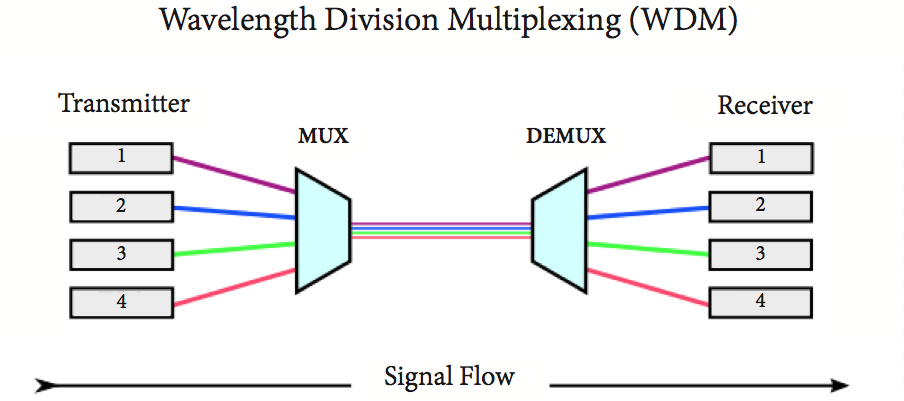The unceasingly demand for Internet-based services makes carrier IP networks a more critical social infrastructure. Operators are required to offer higher speeds, larger capacities and higher reliability network. There emerge two solutions to tackle this issue: IP/WDM and IP/OTN. IP/WDM consists of core routers connected directly over point-to-point WDM links, whereas IP/OTN connects the core routers through a reconfigurable optical backbone (OTN) consisting of electro-optical cross-connects (OXCs) interconnected in a mesh WDM network. This article guides you to choose between them.
Basics of WDM Technology
WDM technology is nothing new for us since it is rather prevalent especially for long haul data transmission. Its ability to provide potentially unlimited transmission capacity remains to be the most featured benefits. Either by simply upgrading the equipment or by increasing the number of lambdas on the fiber, network capacity can be obtained. It is the best choice for applications where channel density/bandwidth is of high priority. Aside from the bandwidth advantage, it also possesses these compelling merits.

- Transparency—Being a physical layer architecture, WDM can transparently support both TDM and data formats such as ATM, Gigabit Ethernet, ESCON, and Fibre Channel with open interfaces over a common physical layer.
- Scalability—WDM can leverage the abundance of dark fiber in many metropolitan area and enterprise networks to quickly meet demand for capacity on point-to-point links and on spans of existing SONET/SDH rings.
- Dynamic provisioning—Fast, simple, and dynamic provisioning of network connections enable high-bandwidth services in days rather than months.
OTN Network Explanation
ITU-T defines OTN as a set of optical network elements (ONE) connected by optical fiber links, being able to provide functionality of transporting, multiplexing, switching, management, supervision and serviceability of optical channels carrying client signals. OTN was designed to optimize existing resources of a transport network. It is a digital wrapper that provides an efficient and globally accepted way to multiplex different services onto optical light paths. The advantages of OTN consist of the following aspects.

- It has the facility to work with DWDM and SDH equipment within banded or mesh networks.
- Transmits SDH services, without termination of the signal at each network element, the signal transport is transparent including the clock and byte header.
- Easily combine multiple networks and services on a common infrastructure entirely in the optical domain and transparent to the format and the speed of the signal carrying client, allowing you to create a multi-platform client.
- The OTN services offering is gully software programmable via a single line card, so that the protocols, connectivity and functionality can be reprogrammed remotely as they change services or customers.
IP/WDM vs. IP/OTN: How to Choose From?
Before we go any further, let’s first look at the basic architecture of each. In the IP/WDM architecture, core routers are connected directly over point-to-point WDM links, whereas in the IP/OTN architecture, they are connected through a reconfigurable optical backbone (OTN) consisting of electro-optical cross-connects (OXCs) interconnected in a mesh WDM network. (See the figure below). We assume that each Point of Presence (PoP) or CO (Central Office) consists of four IP routers. It is clear that in IP/WDM, the routers are connected directly to the WDM systems, which connect them to neighboring PoPs. On the other hand, in IP/OTN, there is an intermediate element (OXC) which is responsible for connecting IP routers from different PoPs.

The major differences of these two approaches include the following aspects:
1. In IP/WDM, traditional transport functions such as switching, grooming, configuration and restoration are eliminated from the SONET/SDH layer and moved to the IP layer which is supposed to be enhanced by MPLS. Alternatively, the optical layer is the one that deals with the aforementioned, exploiting the intelligence of OXCs.
2. IP/OTN solution is more scalable than IP/WDM since the core of the network is based on the more scalable OXCs rather than IP routers.
3. IP/OTN is more flexible to traffic changes than IP/WDM.
4. IP/OTN, the optical transport layer provides the restoration services in a fast and scalable way (optical shared mesh restoration), whereas in IP/WDM restoration is achieved by IP rerouting which is a slow process and may lead to instability in the network.
5. When comparing the cost, IP/WDM appears to be a more cost-prohibitive solution than the IP/OTN architecture. Furthermore, as years go by and total traffic increases, the cost difference between both architectures is more severe.
Conclusion
From what we presented in the article, it is clear that IP/OTN is a more cost-efficient solution. And the savings increase rapidly with the number of nodes and traffic demands between them. Furthermore, IP/OTN is superior over IP/WDM in other qualitative terms like scalability, availability and resiliency. FS.COM endeavors to provide cost-effective and feasible optical network solutions. For more information, please visit www.fs.com.

No comments:
Post a Comment